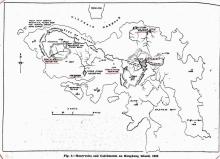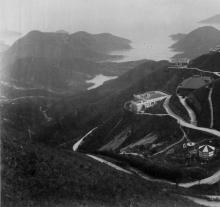Timeline:
- 1890: A reservoir is built here by the Tai Shing Paper Manufacturing Company, Limited, to provide water for their paper mill. Its initial capacity was 44.2 million gallons. Early references call it the "Paper Mill Dam" or "Paper Works Dam".
- 1899-1900: The dam was raised 18 feet, increasing the capacity to 92 million gallons.
- 1929: In March the government took possession of the dam, as part of the "Aberdeen scheme" to expand the water storage in Aberdeen valley. This scheme included building a second reservoir, the Aberdeen Upper Reservoir, to add a further 175 million gallons of water capture and storage.
- 1931: The dam is partially demolished.
- 1932: The reconstruction of the dam is completed. Its capacity after the work is given as 80 million gallons. (This is less than the capacity quoted for the old dam, but see the comments about silt in 1933.)
- "The old dam which was of the buttress type had a length at road level of 440 feet, a maximum depth below overflow level to stream bed of sixty-three feet and was provided with one 9" draw-off and one 18" washout each being controlled by a single sluice valve on the up-stream face and exposed to the water. The length of the overflow, at a level of 261.85 A.O.D. and which was continuous over the main section of the dam, was 110 feet. Access across the top was made by means of light steel trestles supporting timber bearers and planking. The old dam was constructed of various grades of displacer concrete, generally of poor qualify in the interior with better material near the faces. The whole of the facing was of hard blue rubble set in cement mortar.
The reconstructed dam is of the gravity type throughout, the construction of which necessitated the cutting away of parts of the old buttresses and filling in the spaces betv-een them so that the down stream face now presents a uniform appearance. The new overflow at a level of 263.50 A.O.D, was formed by a series of twenty-five rectangular openings each 9'-3" wide by 3-6" deep separated by piers 9" thick Supporting the beams and decking which carry the road-way across the overflow. The roadway at a level of 267.50 A.O.D. is continuous across the dam and has a clear width of 6'-0" between parapets."
- "The old dam which was of the buttress type had a length at road level of 440 feet, a maximum depth below overflow level to stream bed of sixty-three feet and was provided with one 9" draw-off and one 18" washout each being controlled by a single sluice valve on the up-stream face and exposed to the water. The length of the overflow, at a level of 261.85 A.O.D. and which was continuous over the main section of the dam, was 110 feet. Access across the top was made by means of light steel trestles supporting timber bearers and planking. The old dam was constructed of various grades of displacer concrete, generally of poor qualify in the interior with better material near the faces. The whole of the facing was of hard blue rubble set in cement mortar.
- 1933: The reservoir was emptied at the start of the year, and silt removed. The capacity increased to 97.58 million gallons.
- 1934: More silt was removed, increasing the capacity to 106.89 million gallons. That brings the reservoir to its current configuration, as the modern capacity of the lower reservoir is given as 486,000 cubic metres, or 107 million gallons.
The early information about the dam comes from a comprehensive description of Hong Kong's water situation given by the Governor (Sir Cecil Clementi) to Legco on 5th September, 1929. Extracts:
[...] There is also in the Aberdeen valley a storage reservoir constructed in 1890 by the Tai Shing Paper Manufacturing Company. Its capacity, when first built, was 44.2 million gallons. In the years 1899 and 1900 its dam was raised 18 feet to its present level, thus increasing the storage by 47.8 million gallons to a total capacity of 92 million gallons. From this reservoir the Company is required by the terms of its Crown lease to supply the Aberdeen and Aplichau villages with 60,000 gallons a day; and, in order to improve this supply, the Government in 1897 constructed a small covered service reservoir and three filter-beds. The Company’s own reservoir was, however, resumed by the Hong Kong Government in March last, as an initial step towards the extension of the waterworks in Aberdeen valley, a matter to which I shall revert later on. The Ap-li-chau supply was obtained by waterboats until 1928, when a 2" pipe-line was laid across the bed of Aberdeen harbour to give this small island a direct service.
[...] It is manifest, therefore, that our first step should be to build more reservoirs; but unfortunately the configuration of Hong Kong is such that storage possibilities on the island are very limited. There is, however, one additional storage scheme, of which this Council has approved, and which is now being carried out, namely that at Aberdeen.
The Aberdeen scheme was approved by resolution of this Council on the 2nd May last. It provides for the resumption by Government of the existing storage reservoir with a capacity of 92 million gallons constructed by the Tai Shing Paper Manufacturing Company in the Aberdeen valley. This resumption has already been effected at a cost of $525,000, of which a sum of $52,500 has been paid on account, the balance being payable early next year. The Company has been granted 183 days, commencing from the 20th July last, to use up its existing stocks. On the expiry of that period Government obtains possession. The Aberdeen scheme further provides for the construction of an additional storage reservoir in this valley, estimated to contain 175 million gallons of water and to cost $9.00,000. The ancillary works, including Catchwaters, mains, filters, an access road and a pumping station, are estimated to cost $1,277,000. The whole of this scheme will be financed by loan. It will much facilitate the supply of water to the western end of Victoria City, where improved distribution is most needed, for water from the Aberdeen valley will be piped to the Elliot filter-beds, which are to be augmented by a rapid gravity filtration plant. At present, when Pok-fu-lam reservoir is depleted, it is often difficult to maintain an adequate supply to the Elliot filter-beds from the Bowen Road Conduit.
[...]
Later information comes from the annual reports of the Public Works Department, and the modern capacity from the WSD website.



Comments
1897 PWD Report -Dam Constructed in 1893
14. Maintenance of Waterworks, Aberdeen:- Filtration of the water supply to this village was begun in May, 1897. and has since been steadily maintained. The works existing prior to that date were of a very limited nature, consisting only of a main and two fountains. which were provided in 1893 when the reservoir for the Paper Mills was constructed. Three services have been laid on in the village, viz., to the Paper Mills, the Police Station and the Docks; each supply is metered.
Source